Chapter 5. Metamorphic Rocks
Overview of Metamorphic Rocks
Agents of Metamorphism
Pressure
All rocks beneath Earth’s surface experience pressure due to the weight of the overlying sediment and rock layers, and with increasing depth there is a corresponding increase in pressure. This pressure—called lithostatic pressure—is equal in all directions. Lithostatic pressure can change the overall rock volume of a rock, such as by pushing the clasts in a sedimentary rock closer together and reducing the pore space between the clasts, but it will not cause a change in the shape of the rock. To change the shape, one part of the rock must be deformed more than another, and that means the forces acting on the rock cannot be equal in all directions.
In contrast to lithostatic pressure, differential pressure (sometimes called directed pressure) does not act equally in all directions, and thus can cause significant changes in the appearance of a rock. Figure 5.1 demonstrates how a mineral can change shape due to differential pressure, in this case with the greatest pressures applied from the top and bottom. Two initially rounded mineral grains (Figure 5.1A) within a sedimentary rock are experiencing the greatest amount of pressure at the contact between the grains (red arrows), and the bonds linking the atoms in this grain will break. The atoms will migrate into an area of lesser pressure and re-form a bond with other atoms in the mineral grain (Figure 5.1B). As a result, the grains will develop a flattened shape where the grain becomes wider in the horizontal direction, perpendicular to the up-and-down direction of greatest pressure (Figure 5.1C).
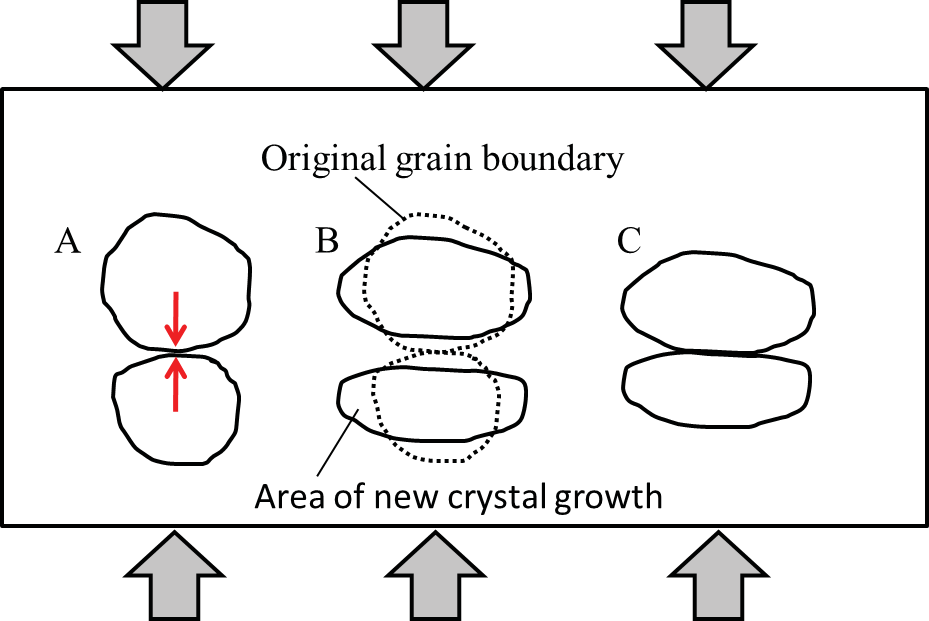
Figure 5.1 shows the deformation of only two grains; in reality, it’s happening to all of the grains in the rock, and in the end, the entire rock will have minerals that are aligned (meaning they’re longer in the same direction). The result is a rock with a metamorphic pattern called a foliation. Foliation causes the rock to have a layered appearance, and to break apart between layers. The layers can be fairly flat if the grains are smaller, or develop a wavy appearance when the grains are larger. You will see some examples of the different forms foliation can take later. Being able to recognize foliation in metamorphic rocks comes in handy for purposes of understanding how the rocks formed, because we can infer something about what forces were acting upon the rocks.
Heat
Increasing pressure can cause metamorphism, and often the increase in pressure is accompanied by an increase in temperature. Heating is also conducive to the presence of chemically reactive fluids, which can accelerate metamorphic changes.
Metamorphic rocks are classified broadly into low, medium and high grades of metamorphic intensity, primarily due to the effects of heat on mineral stability. Heat causes atoms to vibrate; the higher the temperature, the more vibration occurs, and the weaker the bonds between atoms become. Thus, at higher temperatures it’s easier to break the bonds between atoms in a mineral’s structure, leading to the kinds of changes shown in Figure 5.1.
The process of changing the shape and size of crystals in metamorphic rocks is called recrystallization. Often small crystals are fused into fewer, larger crystals. In Figure 5.2, the protolith (A) is a sedimentary rock with small rounded grains, but recrystallization produces larger interlocking grains (B), and the pore spaces are gone. The larger grains are more chemically stable because they have a lower surface area to volume ratio.

Increased grain size is not the only kind of metamorphic transformation. Sometimes minerals within the rock can be transformed into new minerals when specific temperature and pressure conditions are reached. Because these minerals are indicative of specific metamorphic conditions, they are called index minerals.
Metamorphic Rock Names
Foliated Metamorphic Rocks
Differential pressures can cause a metamorphic pattern known as foliation to develop in metamorphosed rocks. There are a few types of foliation that are commonly seen in metamorphic rocks, and the type is a function of the minerals that define the foliation.
Gneiss (pronounced “nice”; Figure 5.3) is a metamorphic rock with foliation that presents as alternating bands of dark and light minerals throughout the rock. This type of foliation is referred to as gneissic banding. In Figure 5.3A, the sample is sitting with colour bands running roughly horizontally, indicating that the greatest pressure on the rock was applied in what is the up-and-down direction in the photo (i.e., at right angles to the orientation of the banding). If differential pressure were applied to the gneiss after the bands formed, they might not be flat like the ones in Figure 5.3A, but folded or convoluted like the ones in Figure 5.3B.
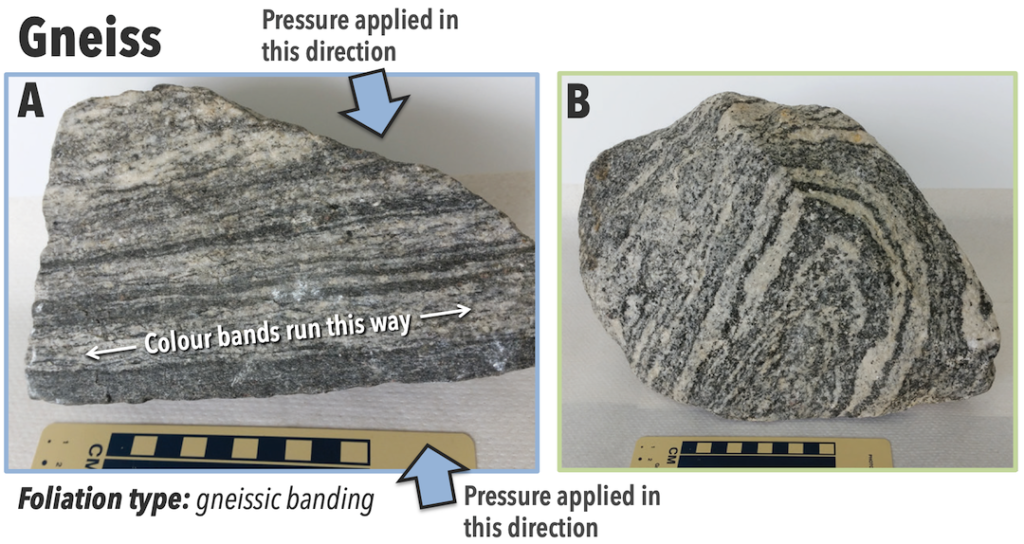
Biotite and amphibole are common minerals in the darker bands, and the lighter bands tend to contain feldspar and quartz. The protolith for gneiss can be any rock that contains more than one mineral, such as shale with its clay minerals and clay-sized quartz and feldspar, or an igneous rock with both dark-coloured ferromagnesian minerals and light-coloured non-ferromagnesian minerals. In order for gneissic foliation to develop, temperatures and pressures need to be quite high; for this reason, gneiss rocks represent a high grade of metamorphism.
Other kinds of foliation cause rocks to break along more-or-less parallel layers. This a property called rock cleavage. If you look carefully at rocks with well-developed rock cleavage, you can spot areas where the foliation gives the appearance of book pages viewed edge-on. Like some of the page edges in Figure 5.4, foliation can create wavy surfaces as well as flat ones.
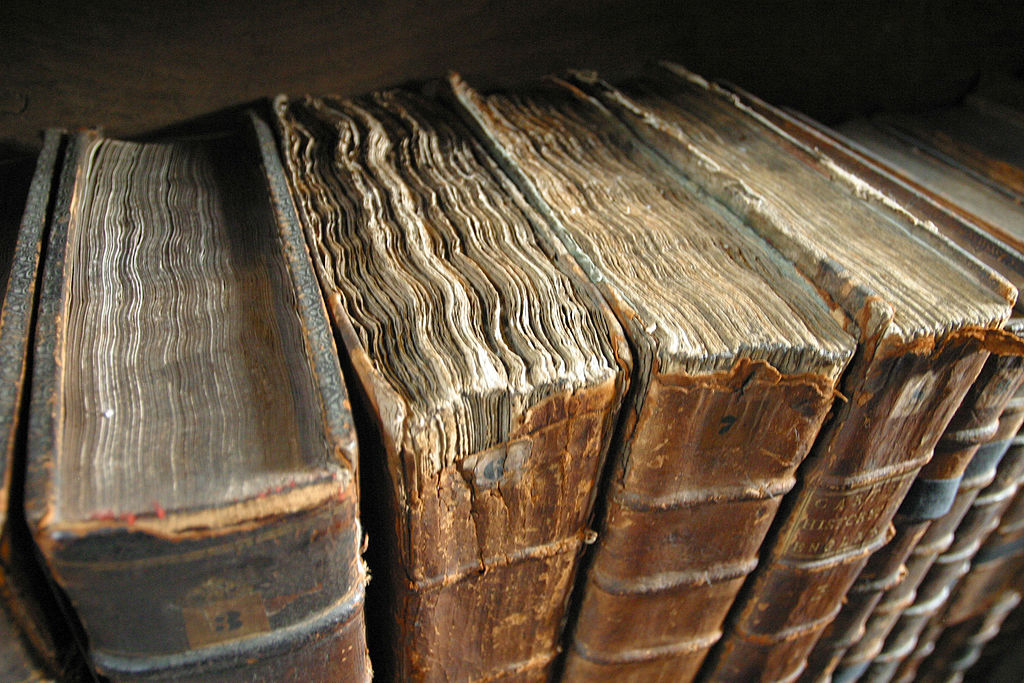
Metamorphic rocks with a foliation pattern defined by the layering of platy minerals (such as muscovite or biotite micas) are called schist. The rock name is commonly modified to indicate what mica is present. For example, Figure 5.5 is muscovite schist with garnet present, so the correct name for this rock is a garnet muscovite schist. By convention, when naming a metamorphic rock the mineral in the lowest quantity is mentioned first.
The muscovite micas define a very wavy foliation in the rock, called a schistose foliation (Figure 5.5B). Shale is usually the protolith for schist; during metamorphism, the very tiny clay minerals in shale recrystallize into micas that are large enough to see without magnification. Temperatures and pressures necessary for schistose foliation are not as high as those for gneiss, therefore schists represent an intermediate grade of metamorphism.
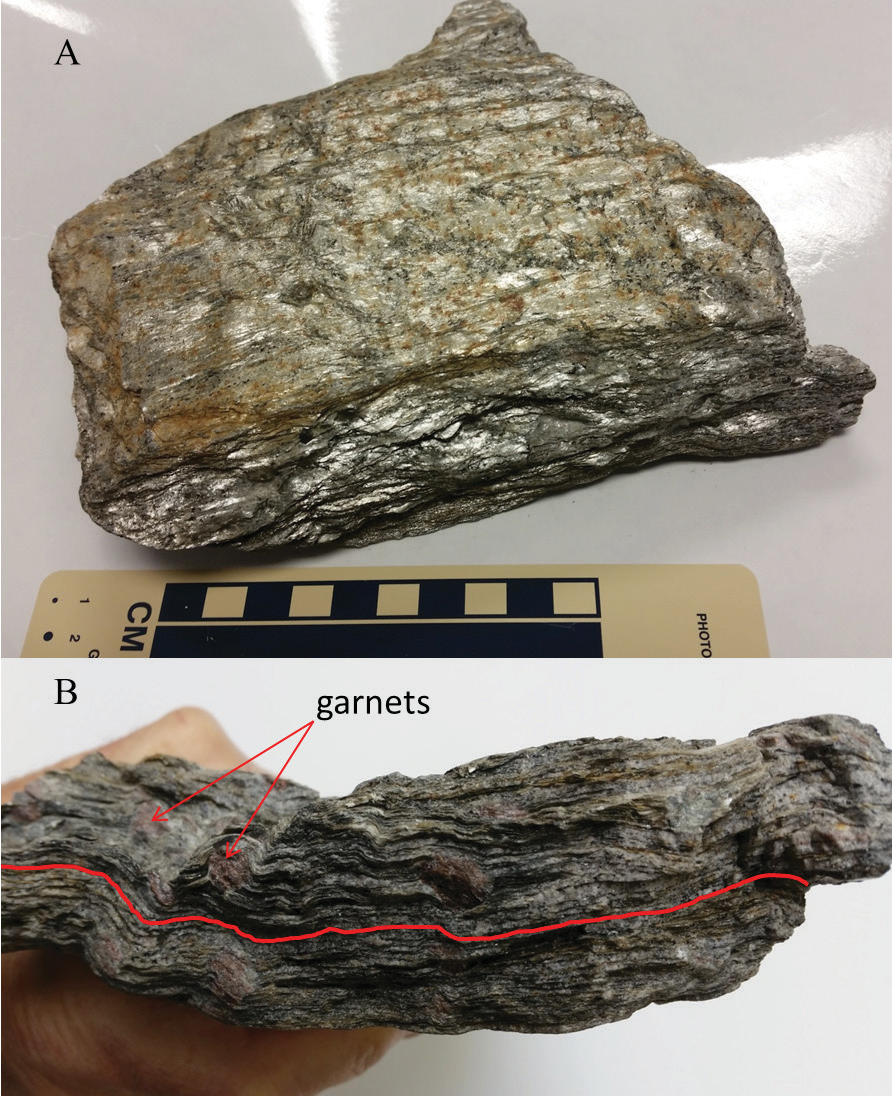
In schist and gneiss the crystals making up the rock are visible without magnification, but this is not the case for all foliated metamorphic rocks. Phyllite (Figure 5.6) is a metamorphic rock made up of fine crystals that give the rock a satin sheen. This rock displays phyllitic foliation, which has good, sometimes wrinkled or folded, cleavage. Phyllites are generally formed from a shale protolith, with the clay minerals in the shale aligning and recrystallizing as small mica minerals. This foliation develops under temperatures and pressures less than those for schist and represent a low to intermediate grade of metamorphism.
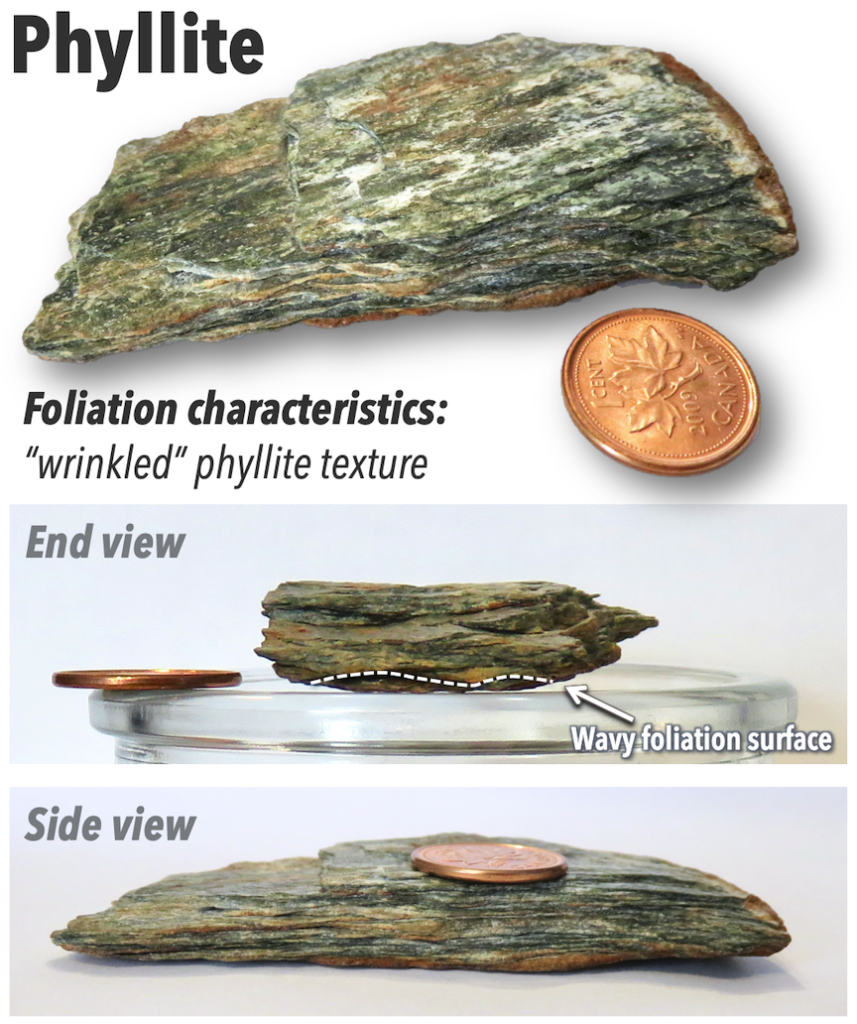
Slate (Figure 5.7) forms by the low temperature and pressure alteration of a shale protolith. The clay-sized minerals in the shale recrystallize into very tiny micas, which are larger than the clay minerals, but still too small to be visible. The alignment of these micas causes the shale to break into flat sheets parallel to the mica alignment. This is called slaty cleavage. The sample in Figure 5.7 is interesting because there is still evidence of the original sedimentary layering (highlighted in the lower right of the sample), but because of metamorphism, the slaty cleavage now cuts through those layers. Slate is an example of a low grade metamorphic rock, and as with the original sedimentary features, fossils are also occasionally preserved.

Non Foliated Metamorphic Rocks
Non foliated; metamorphic rocks lack foliation. This can happen when differential pressure is not involved in the making of the rock, such as when metamorphism happens primarily by rocks being heated by an igneous intrusion. An absence of foliation can also occur if the protolith is composed only of certain minerals. Minerals like calcite (if the protolith were limestone) and quartz (in a sandstone protolith) recrystallize into coarse equigranular (meaning the crystals are all approximately the same size) crystals. Neither quartz nor calcite are platy minerals, so foliation does not develop. A metamorphic rock consisting of coarse blocky crystals is said to have a granofelsic texture. Although this term has “felsic” in it, it does not mean the composition is felsic. Instead it invokes the kind of texture you’d find in granite.
The metamorphic rocks that form when quartz and calcite rocks recrystallize are classified according to their composition, not by foliation type. When quartz-rich sandstone is metamorphosed, the result is the metamorphic rock quartzite (Figure 5.8). When limestone is metamorphosed, the result is marble (Figure 5.9).
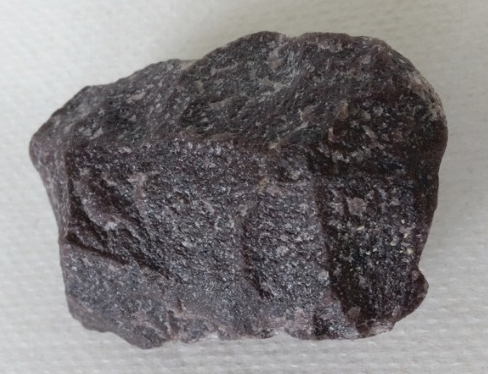
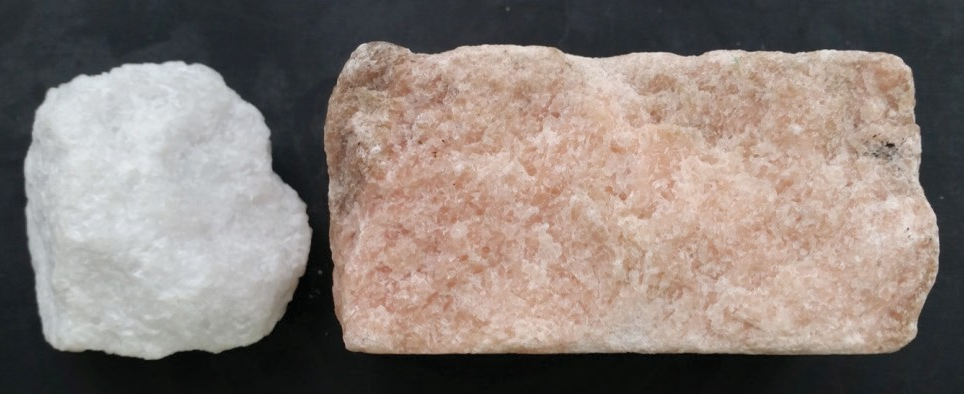
Quartzite and marble can be hard to identify based on appearance alone (they can in fact look identical), therefore, you must rely on the properties of the minerals that comprise these rocks. Recall that quartz is harder than glass, while limestone is softer than glass.
Some metamorphic rocks, such as hornfels, have no visible texture, due to being very fine-grained. Hornfels is predominantly the result of heating fine-grained rocks such as shale and basalt, and reactions with very hot fluids. A unique feature of hornfels is that sometimes much larger mica crystals form amid the fine-grained material as a result of chemical reactions (Figure 5.10), producing what are sometimes called cherry blossom stones.
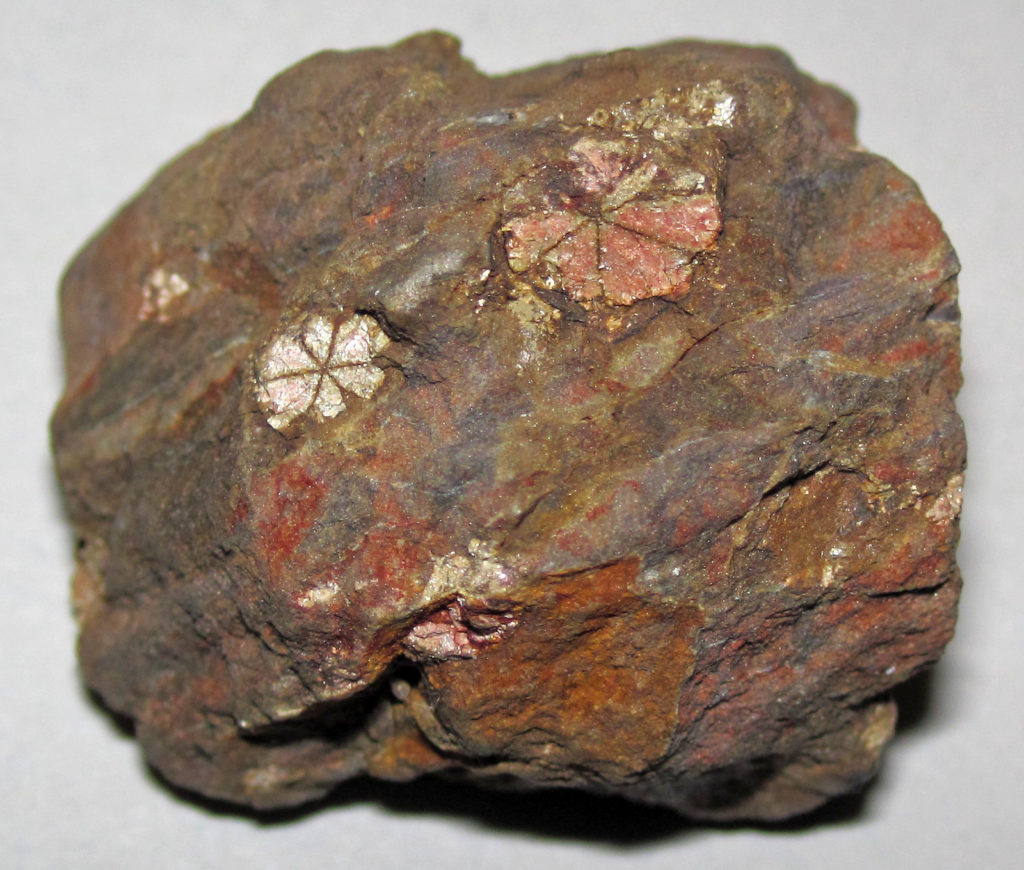
Coal As A Metamorphic Rock
Coal forms from terrestrial plant matter that is heated and compressed. At temperatures and pressures under which sedimentary rocks form, the result is the types of coal called lignite and bituminous coal. Under metamorphic conditions, however, a different type of coal, called anthracite, forms (Figure 5.11). Unlike woody lignite, and tarry-smelling bituminous coal, anthracite is black, smooth, and shiny. If you see a rock that looks like obsidian, but is unusually light and soft, you might be looking at anthracite.
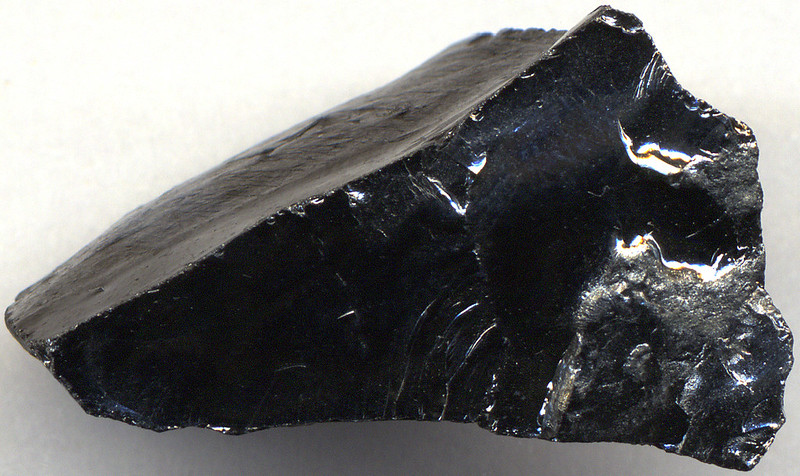
Identifying Metamorphic Rocks
In order to name metamorphic rocks, a logical first step is to examine the rock for evidence of any pattern or foliation. If foliation is present, noting the type of foliation will allow you to identify the rock. If the rock is non foliated, use the physical properties of the materials making up the rock. Figure 5.12 summarizes the metamorphic rocks covered in this chapter, including foliation types, protoliths, and rock names.
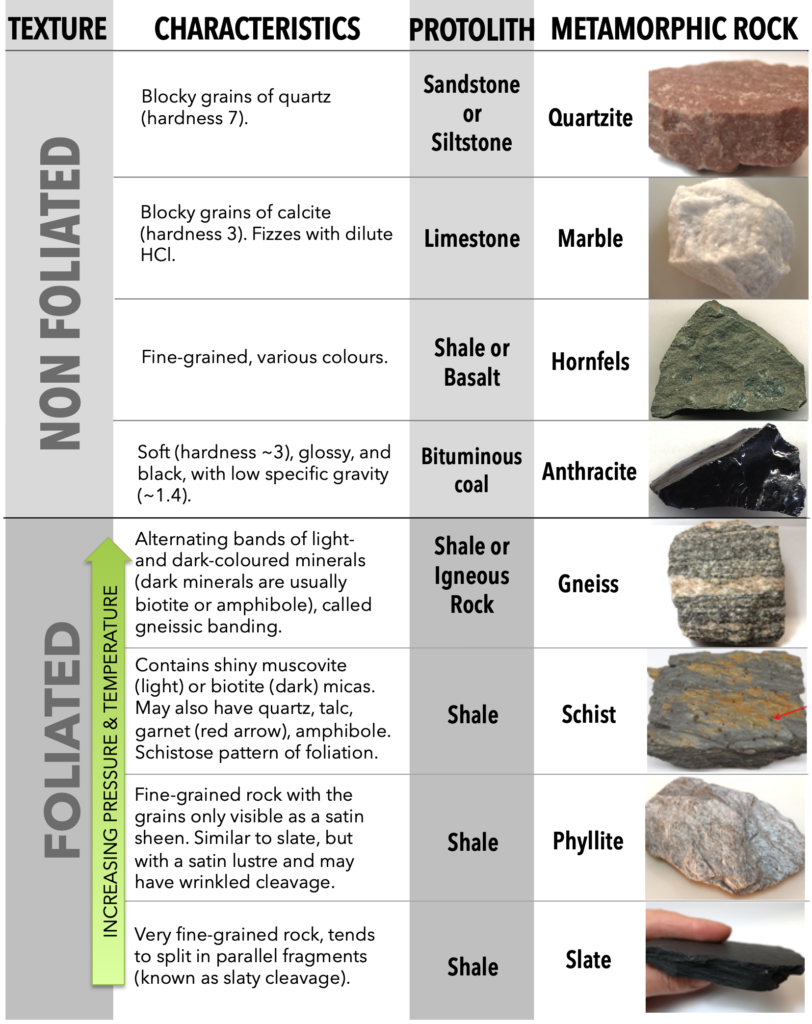
Crystals are all approximately the same size.

